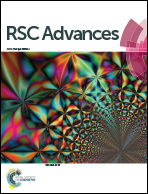Electrochemical polymerization of 1,4-di(aryl)cyclopentadienes: thin-film optical and electronic properties†
Abstract
A comparative study of the electrochemical polymerization of 1,4-di(aryl)-5,5-dimethylcyclopentadienes (ArC5Ar) as a function of aryl group identity (Ar = thienyl, Th; furyl, Fur; and N-methylpyrrolyl; Pyr groups) is presented. The solubility of charged species generated at the surface of the working electrode impedes efficient polymer deposition with only ThC5Th and FurC5Fur monomers affording films suitable for analysis. Films of poly(ThC5Th) and poly(FurC5Fur) possess a UV-vis absorption maxima λmax of 500 nm and 400 nm respectively, that bleach upon oxidation giving rise to low energy charge-carrier absorption features that are consistent with those observed in their aromatic congeners. Film formation is vastly improved by copolymerizing ArC5Ar in the presence of 1,3,5-tris(2-aryl)benzenes (3ArB), electroactive monomers that serve as anodically activated cross-linking agents. Spectroelectrochemical analyses reveal that copolymer films possess higher energy absorption signatures in both the neutral and oxidized state when compared to their corresponding homopolymer, a consequence of the meta-substituted arrangement of 3ArB that is expected to reduce conjugation across the polymer backbone. Based on the thiophene-containing systems, these optical signatures can be tailored towards poly(ThC5Th) by reducing the feed ratio of 3ThB in the comonomer solution, indicating that film deposition can be improved with the use of an additive without compromising the properties observed in the homopolymer.


 Please wait while we load your content...
Please wait while we load your content...